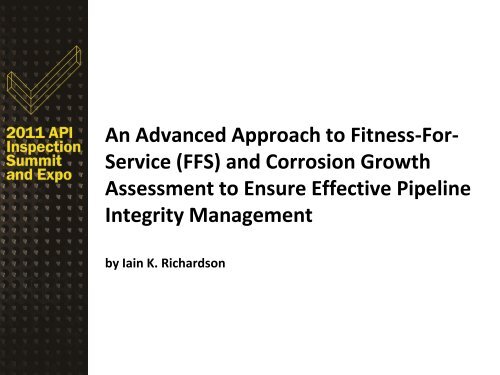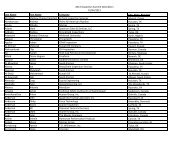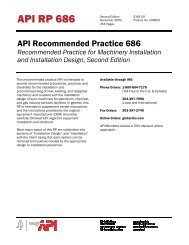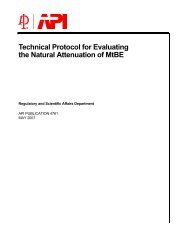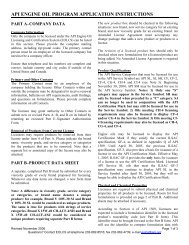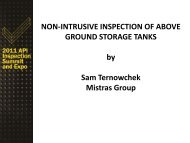An Advanced Approach to Fitness-For-Service (FFS) and Corrosion ...
An Advanced Approach to Fitness-For-Service (FFS) and Corrosion ...
An Advanced Approach to Fitness-For-Service (FFS) and Corrosion ...
Create successful ePaper yourself
Turn your PDF publications into a flip-book with our unique Google optimized e-Paper software.
<strong>An</strong> <strong>Advanced</strong> <strong>Approach</strong> <strong>to</strong> <strong>Fitness</strong>-<strong>For</strong>-<br />
<strong>Service</strong> (<strong>FFS</strong>) <strong>and</strong> <strong>Corrosion</strong> Growth<br />
Assessment <strong>to</strong> Ensure Effective Pipeline<br />
Integrity Management<br />
by Iain K. Richardson
Iain K. Richardson<br />
BEng(Hons.) CEng MIMechE<br />
Past Experience<br />
� 1996 – 1999 : Applications Engineer with Vickers plc. – Michell Bearings.<br />
� 1999 – 2002 : Development Engineer with PII Pipeline Solutions (GE-PII)<br />
� 2002 – 2009 : Global Sales & Marketing Manager with Rolls-Royce plc. –<br />
Michell Bearings<br />
Current Role (2009 - )<br />
� Senior Integrity Engineer within MACAW's Pipeline Integrity Group<br />
which provides services relating <strong>to</strong> pipeline risk assessment, corrosion<br />
management, fitness for service <strong>and</strong> corrosion growth assessments for<br />
clients world-wide.
� Purpose of Presentation<br />
� To demonstrate the steps taken <strong>to</strong> provide the client with<br />
a <strong>Fitness</strong>-for-<strong>Service</strong> Assessment, utilizing detailed<br />
<strong>Corrosion</strong> Growth methods <strong>to</strong> ensure ongoing operation<br />
<strong>and</strong> safety of a 12” x 30 mile refined product pipeline.<br />
� Data Sources<br />
� ROSEN In-Line Inspection Survey Report (0-1000-11210),<br />
August 2009<br />
� ROSEN/MACAW <strong>Fitness</strong>-<strong>For</strong>-<strong>Service</strong> Report, March 2010.
Scope of Work<br />
• Review findings of the latest intelligent pig inspection <strong>and</strong><br />
identify potential causes of corrosion.<br />
• Assess significance of the reported anomalies (corrosion / other)<br />
in terms of immediate integrity of the pipeline.<br />
• Identify <strong>and</strong> prioritise anomalies which require immediate repair<br />
(in-line with DOT 49CFR195 regulations).<br />
• Utilize available pipeline information <strong>and</strong> recent & previous<br />
inspection data sets <strong>to</strong> estimate appropriate corrosion growth<br />
rates.<br />
• Develop a rehabilitation plan for the pipeline, including a long<br />
term repair plan.<br />
• Recommend appropriate repair methods for any repairs<br />
identified.<br />
• Identify an appropriate re-inspection interval.
Pipeline Summary<br />
• 12” x 30 mile refined product pipeline.<br />
• Constructed in 1975 from seamless pipe.<br />
• API 5L Grade X42.<br />
• The nominal wall thickness varies from 0.188” <strong>to</strong> 0.322”.<br />
• Reported Maximum Operating Pressure (MOP) is 850 psi.<br />
• Tar Tape Wrap Coating.<br />
• Impressed current CP system.<br />
• Inspected in 2009 by ROSEN (CDX) <strong>and</strong> in 2006 by ROSEN<br />
(CDP & EGP).
Summary of Inspection Findings<br />
Feature Type 2006 Inspection 2009 Inspection<br />
External <strong>Corrosion</strong> 2434 2455<br />
Manufacturing <strong>An</strong>omalies 178 196<br />
Girth Weld <strong>An</strong>omalies 1 2<br />
Dents 31 43<br />
Deformation <strong>An</strong>omalies 715 485<br />
Extra Metal 5 4<br />
Eccentric Casings 5 0<br />
Repairs (metal sleeves &<br />
composite wraps)<br />
0 778
Internal <strong>Corrosion</strong><br />
• The pipeline transports refined product.<br />
• Therefore a low level of water would be expected internally.<br />
• A corrosion inhibi<strong>to</strong>r is injected in<strong>to</strong> the product.<br />
• Both the 2006 <strong>and</strong> the 2009 inspections did not report any<br />
internal corrosion features.<br />
• On this basis the threat of internal corrosion is considered <strong>to</strong><br />
be low in this pipeline.
External <strong>Corrosion</strong><br />
Orientation - Degrees<br />
360<br />
315<br />
270<br />
225<br />
180<br />
135<br />
90<br />
45<br />
0<br />
0 5 10 15 20 25 30<br />
Distance - miles<br />
External <strong>Corrosion</strong> Features 10 <strong>to</strong> 20%WT External <strong>Corrosion</strong> Features 21 <strong>to</strong> 30%WT<br />
External <strong>Corrosion</strong> Features 31 <strong>to</strong> 40%WT External <strong>Corrosion</strong> Features 41 <strong>to</strong> 50%WT<br />
External <strong>Corrosion</strong> Features 51 <strong>to</strong> 60%WT External <strong>Corrosion</strong> Features 61 <strong>to</strong> 70%WT<br />
External <strong>Corrosion</strong> Features 71 <strong>to</strong> 80%WT<br />
• Area of low level external corrosion in the first ~7 miles.<br />
• Concentration of deeper (79%wt) external corrosion features<br />
between ~7.2 - 9.4 miles close <strong>to</strong> rectifier.<br />
• Two concentrations of deeper external corrosion features at<br />
the end of the pipeline at ~28 miles.<br />
1400<br />
1200<br />
1000<br />
800<br />
600<br />
400<br />
200<br />
0<br />
Elevation (ft)
External <strong>Corrosion</strong><br />
• Location 1: 0-7 Miles<br />
– Depleted ground bed at the start of the line - CP underprotection<br />
– Ground bed <strong>to</strong> be re-instated<br />
• Location 2: 7.2-9.4 Miles<br />
– Coating disbondment<br />
– Rectifier no power (between 2004-2006)<br />
• Location 3: at ~28 Miles<br />
– Two foreign line crossings, potential stray current issue<br />
– Corrosive soil, resistivity of 1000 Ω-cm, poor coating condition<br />
– Rectifier <strong>to</strong> be installed <strong>to</strong> raise potentials, or re-coating of ~5<br />
miles<br />
• Large number of repairs completed including remedial work on<br />
CP system<br />
• A potential disbonded coating issue remains
External <strong>Corrosion</strong><br />
Signal comparison showing evidence of disbonded coating<br />
• Potential for microbial corrosion <strong>to</strong> occur in areas of anaerobic<br />
soil
Manufacturing <strong>An</strong>omalies<br />
Orientation - degrees<br />
360<br />
315<br />
270<br />
225<br />
180<br />
135<br />
90<br />
45<br />
0<br />
0<br />
0 5 10 15 20 25 30 35<br />
Distance - Miles<br />
Orientation Elevation<br />
• The majority (91%) are
Girth Weld <strong>An</strong>omalies<br />
• The 2009 inspection reported 2 metal loss girth weld<br />
features.<br />
• The anomalies are considered <strong>to</strong> have been introduced<br />
during the construction process.<br />
• Are considered <strong>to</strong> have survived any pre-service hydrostatic<br />
pressure test.<br />
• In the absence of a growth mechanism, they are not<br />
expected <strong>to</strong> affect the integrity of the pipeline.
Dent / Deformation <strong>An</strong>omalies<br />
Orientation (degrees)<br />
360<br />
315<br />
270<br />
225<br />
180<br />
135<br />
90<br />
45<br />
0<br />
0<br />
0 5 10 15 20 25 30<br />
Distance (Miles)<br />
• 485 deformation anomalies less than 2% OD<br />
• 43 dents greater than 2% OD, the deepest of which was reported <strong>to</strong><br />
be 4.4% OD.<br />
1400<br />
1200<br />
1000<br />
800<br />
600<br />
400<br />
200<br />
Concentration<br />
in particularly<br />
rocky area<br />
Elevation (ft)
Dent / Deformation <strong>An</strong>omalies – DOT Requirements<br />
Position of<br />
Feature on<br />
Pipeline<br />
Top of line<br />
(above 4-8<br />
o’clock)<br />
Bot<strong>to</strong>m of line<br />
(between 4-8<br />
o’clock)<br />
On Girth<br />
Weld/Seam<br />
Weld<br />
Priority 1 - Immediate Priority 2 – 60 day Priority 3 – 180 day<br />
Repair<br />
Condition<br />
Depth<br />
>6%OD or<br />
With<br />
associated<br />
metal loss,<br />
cracking or<br />
stress riser<br />
Number of<br />
Features<br />
32<br />
N/A N/A<br />
Repair<br />
Condition<br />
Depth<br />
>3%OD<br />
With<br />
associated<br />
metal loss,<br />
cracking or<br />
stress riser<br />
Number of<br />
Features<br />
2<br />
89<br />
N/A N/A N/A N/A<br />
Repair<br />
Condition<br />
Depth<br />
>2%OD<br />
Depth<br />
>6%OD<br />
Depth<br />
>2%OD<br />
TOTAL 32 91 4<br />
Number of<br />
Features<br />
4<br />
0<br />
0
Extra Metal <strong>An</strong>omalies<br />
Orientation - degrees<br />
360<br />
315<br />
270<br />
225<br />
180<br />
135<br />
90<br />
45<br />
0<br />
0<br />
0 5 10 15 20 25 30 35<br />
Distance - Miles<br />
Orientation Elevation<br />
• Extra metal features close <strong>to</strong> or <strong>to</strong>uching the pipeline can<br />
damage the protective coating <strong>and</strong>/or affect the performance<br />
of the cathodic protection system.<br />
• There is no external corrosion located in the vicinity of these<br />
features, therefore they are considered <strong>to</strong> be insignificant in<br />
terms of the integrity of the pipeline.<br />
1400<br />
1200<br />
1000<br />
800<br />
600<br />
400<br />
200<br />
Elevation - ft
Immediate Integrity Assessment<br />
• Assessment Pressure: MAOP 850 psi<br />
• The corrosion anomalies were assessed:<br />
– <strong>to</strong> Modified B31G in terms of their axial dimensions<br />
– <strong>An</strong>omalies that require repair within 5 years have also<br />
been assessed <strong>to</strong> Detailed RSTRENG<br />
– Kastner in terms of circumferential dimensions<br />
• The manufacturing <strong>and</strong> girth weld features were assessed <strong>to</strong><br />
Shannon <strong>and</strong> Kastner<br />
• <strong>An</strong>omalies require repair if:<br />
– Their reported dimensions exceed the size <strong>to</strong>lerable at the<br />
MAOP x safety fac<strong>to</strong>r (1.39); or<br />
– Their maximum reported depths exceed 80% wt.<br />
• The assessment has been conducted allowing for <strong>to</strong>ol depth<br />
sizing <strong>to</strong>lerances
Peak Depth (%wt)<br />
Immediate Integrity – Axial Dimensions<br />
100<br />
90<br />
80<br />
70<br />
60<br />
50<br />
40<br />
30<br />
20<br />
10<br />
0<br />
0 5 10 15 20 25 30 35 40<br />
Axial Length (inch)<br />
Modified B31.G @ Assessment Pressure (68% SMYS, 58.6 bar)<br />
Modified B31.G @ Assessment Pressure x 1.39 (95% SMYS, 81.5 bar)<br />
External <strong>Corrosion</strong> Features<br />
Features Reported as Repaired in ROSOFT<br />
• 45 corrosion features were found <strong>to</strong> be unacceptable<br />
• Assessment <strong>to</strong> Detailed RSTRENG reduces the number of<br />
unacceptable corrosion features <strong>to</strong> 24
Immediate Integrity – Circumferential Dimensions<br />
Peak Depth (%wt)<br />
100<br />
90<br />
80<br />
70<br />
60<br />
50<br />
40<br />
30<br />
20<br />
10<br />
0<br />
0 5 10 15 20 25 30 35 40<br />
Circumferential Length (inches)<br />
Kastner @ Assessment Pressure (34% SMYS, 58.6 bar)<br />
Kastner @ Assessment Pressure x 1.39 (48% SMYS, 81.5 bar)<br />
External <strong>Corrosion</strong> Features<br />
Features Reported as Repaired in ROSOFT<br />
• 4 external corrosion features were found <strong>to</strong> be unacceptable<br />
• These were also found <strong>to</strong> be unacceptable in terms of their<br />
axial <strong>and</strong> depth dimensions (with <strong>to</strong>lerances).
Immediate Integrity – Manufacturing / Weld <strong>An</strong>omalies<br />
Peak Depth (%wt)<br />
100<br />
90<br />
80<br />
70<br />
60<br />
50<br />
40<br />
30<br />
20<br />
10<br />
0<br />
0 1 2 3 4 5 6<br />
Axial Length (inches)<br />
Shannon @ Assessment Pressure (68% SMYS, 58.6 bar)<br />
Shannon @ Assessment Pressure x 1.39 (95% SMYS, 81.5 bar)<br />
Manufacturing/weld <strong>An</strong>omalies<br />
Peak Depth (%wt)<br />
100<br />
90<br />
80<br />
70<br />
60<br />
50<br />
40<br />
30<br />
20<br />
10<br />
• All of the<br />
manufacturing /<br />
weld anomalies<br />
were found <strong>to</strong> be<br />
acceptable<br />
0<br />
0 1 2 3 4 5 6<br />
Circumferential Length (inches)<br />
Kastner @ Assessment Pressure (34% SMYS, 58.6 bar)<br />
Kastner @ Assessment Pressure x 1.39 (48% SMYS, 81.5 bar)<br />
Manufacturing/weld <strong>An</strong>omalies
DOT 49CFR195 High Consequence Area Requirements<br />
Immediate Repair<br />
• Calculation of the remaining strength of the pipe (using ASME/ANSI B31G;<br />
RSTRENG) shows a predicted burst pressure less than the established maximum<br />
operating pressure at the location of the anomaly.<br />
• In addition any metal loss greater than 80% wt is also considered <strong>to</strong> be an<br />
immediate repair regardless of the feature dimensions.<br />
180 – Day Conditions<br />
• Calculation of the remaining strength of the pipe shows an operating pressure<br />
that is less than the current established maximum operating pressure at the<br />
location of the anomaly. <strong>For</strong> this pipeline this has been calculated by assuming<br />
that the pipeline is operating at 72% SMYS resulting in a safety fac<strong>to</strong>r of 1.39.<br />
• <strong>An</strong> area of general corrosion with a predicted metal loss greater than 50% wt.<br />
• Predicted metal loss greater than 50% of nominal wall that is located at a<br />
crossing of another pipeline, is in an area with widespread circumferential<br />
corrosion, or is in an area than could affect a girth weld.<br />
• <strong>Corrosion</strong> of, or along a longitudinal seam weld.<br />
To maintain safety prior <strong>to</strong> any immediate repairs an opera<strong>to</strong>r must temporarily<br />
reduce the operating pressure or shut down the pipeline until the opera<strong>to</strong>r<br />
completes these repairs.<br />
On the basis of the above, 1 external feature requires immediate repair <strong>and</strong> 12<br />
external features require remediation within 180 days of the date of discovery.
<strong>Corrosion</strong> Growth Assessment<br />
• CGA conducted in two stages:<br />
– Feature matching between 2006 <strong>and</strong> 2009 inspections<br />
– Align inspection data <strong>to</strong> common distance<br />
– Comparison of reported feature lists <strong>to</strong> identify features<br />
reported in both inspections<br />
– Estimation of growth rates based on reported<br />
dimensions<br />
– Signal-based comparison <strong>to</strong> validate the growth rates<br />
– Review of 2006 <strong>and</strong> 2009 inspection signals for<br />
selected features
Feature Matching Process<br />
Collect recent<br />
inspection<br />
information<br />
(Feature location,<br />
depth, length,<br />
width)<br />
Define search<br />
window size<br />
(st<strong>and</strong>ard is ± 10cm)<br />
Does any previous<br />
feature overlap with the search<br />
window?<br />
Yes<br />
Is there more<br />
than one previous feature<br />
overlapping?<br />
Yes<br />
Select the<br />
previous feature<br />
with the maximum<br />
depth<br />
No<br />
Move <strong>to</strong> next<br />
feature<br />
No<br />
No<br />
Is there more<br />
than one recent feature<br />
overlapping?<br />
MATCH FOUND<br />
Select the recent<br />
feature with the<br />
maximum depth<br />
Yes
Feature Matching Process<br />
• Distance Correlation<br />
– Use the weld distances <strong>to</strong> align the inspections<br />
– Unique patterns present in weld locations<br />
• Distance Adjustment<br />
– Apply the weld adjustment <strong>to</strong> the features<br />
• Feature Comparison<br />
– Compare the feature locations in both inspections <strong>to</strong> find a match
Feature Matching Process<br />
Previous<br />
Inspection<br />
Recent<br />
Inspection<br />
12:00<br />
06:00<br />
12:00<br />
12:00<br />
06:00<br />
12:00<br />
Reported<br />
location<br />
Reported<br />
location<br />
Reported<br />
feature width<br />
Reported<br />
feature length<br />
User defined<br />
search window<br />
size
Feature Matching Process<br />
65%<br />
55%<br />
37%<br />
18%<br />
23%<br />
39%<br />
Previous<br />
Inspection<br />
Recent<br />
Inspection<br />
52%<br />
83%<br />
50%<br />
45%<br />
51%<br />
51%
Depth (%wt)<br />
<strong>Corrosion</strong> Depth Comparison<br />
100<br />
90<br />
80<br />
70<br />
60<br />
50<br />
40<br />
30<br />
20<br />
10<br />
0<br />
0 5 10 15 20 25 30<br />
Log Distance (miles)<br />
2006 2009 Features Reported as Repaired in ROSOFT<br />
• The majority of the external corrosion occurring on the pipeline<br />
appears <strong>to</strong> be controlled
<strong>Corrosion</strong> Growth Signal Comparison<br />
~ 2m / 6.5ft<br />
Previous Inspection<br />
Recent Inspection
<strong>Corrosion</strong> Growth Signal Reorientation
<strong>Corrosion</strong> Growth Signal Normalization
<strong>Corrosion</strong> Growth Signal Comparison<br />
Clear<br />
Evidence<br />
of growth<br />
No clear<br />
Evidence<br />
of growth
Example Signal Comparison<br />
• Feature with highest confirmed external corrosion growth rate
<strong>Corrosion</strong> Growth Rate (mils/yr)<br />
Signal Comparison Results<br />
60<br />
50<br />
40<br />
30<br />
20<br />
10<br />
0<br />
-10<br />
-20<br />
From<br />
(miles)<br />
To<br />
(miles)<br />
-30<br />
0 5 10 15 20 25 30<br />
Log Distance (Miles)<br />
<strong>Corrosion</strong><br />
Growth Rate<br />
Applied<br />
(mils/yr)<br />
0 27.9 11.4<br />
27.9 End of Pipeline 47.5<br />
Existing <strong>Corrosion</strong> Growth New <strong>Corrosion</strong> Growth<br />
Features showing evidence of <strong>Corrosion</strong> Growth Outlier Feature for Investigation<br />
Minimum Statistical CGR Threshold CGR updated following Signal Comparison
Further Investigations<br />
• 1 feature at 37226.75 ft reported as repaired but not present in<br />
2006 inspection<br />
– Confirm that feature has been repaired<br />
• 1 feature showing evidence of new growth at 45578.69 ft, above<br />
statistical limit<br />
Distance<br />
(ft)<br />
– Confirm origin <strong>and</strong> take steps <strong>to</strong> remove threat as appropriate<br />
37226.75 MELO-<br />
CORR<br />
45578.69 MELO-<br />
CORR<br />
Type O’clock<br />
Position<br />
Length<br />
(in)<br />
Width<br />
(in)<br />
Depth<br />
(% wt)<br />
<strong>Corrosion</strong><br />
Growth Rate<br />
(mils/yr)<br />
04:31 1.535 1.654 64 40<br />
09:25 0.591 0.63 32 20
Future Integrity<br />
400<br />
350<br />
300<br />
250<br />
200<br />
150<br />
100<br />
50<br />
0<br />
Predicted Investigations/Repairs 0-28 miles<br />
2009 2010 2011 2012 2013 2014<br />
Predicted Repairs per Year 2 1 12 28 44 33<br />
Accumulated Repairs 2 3 15 43 87 120<br />
28 miles <strong>to</strong> end<br />
of pipeline<br />
360 features over<br />
5 years<br />
Predicted Repairs per Year Accumulated Repairs<br />
400<br />
350<br />
300<br />
250<br />
200<br />
150<br />
100<br />
50<br />
0<br />
Predicted Investigations/Repairs 28 miles <strong>to</strong> end of Pipeline<br />
2009 2010 2011 2012 2013 2014<br />
Predicted Repairs per Year 7 65 140 148 0 0<br />
Accumulated Repairs 7 72 212 360 360 360<br />
Predicted Repairs per Year Accumulated Repairs<br />
0-28 miles<br />
120 features<br />
over 5 years
Future Integrity<br />
Number of Single Repairs<br />
160<br />
140<br />
120<br />
100<br />
80<br />
60<br />
40<br />
20<br />
0<br />
0 5 10 15 20 25 30<br />
Log Distance (miles)<br />
2009<br />
2010<br />
2011<br />
2012<br />
2013<br />
Year<br />
2014
Rehabilitation Strategy<br />
• Conduct Sectional Repairs/re-coating<br />
• Complete planned mitigation measures<br />
– Replacement of the depleted ground bed at start of pipeline<br />
– Installment of a rectifier <strong>and</strong> deep well ground bed at 25<br />
miles or recoating of the last 5 miles of the pipeline<br />
– It is noted that if coating disbondment is a particular issue in<br />
this area, then either sectional replacement or recoating of<br />
the pipeline would be required <strong>to</strong> control the corrosion<br />
• Conduct re-inspection in 3 years, this will:<br />
– Ensure any further areas of coating disbondment are<br />
identified<br />
– Enable confirmation of external corrosion growth rates<br />
predicted here<br />
– Confirm the effectiveness of any planned mitigation<br />
measures<br />
– Ultimately assist in reducing the numbers of repairs required<br />
in subsequent years
Repair Methods<br />
Type of Defect Grinding<br />
Leak or Defect<br />
>80% wt<br />
External<br />
<strong>Corrosion</strong><br />
Recommendations – External <strong>Corrosion</strong><br />
• Carry out planned mitigation work<br />
• Complete immediate investigations/repairs<br />
• During investigations:<br />
– A check should be made <strong>to</strong> determine if CP shielding<br />
problems exist due <strong>to</strong> disbonded coating<br />
– If this is the case then the area should be recoated<br />
– During the removal of any coating the existence of<br />
MIC can be confirmed by the presence of the smell of<br />
hydrogen sulphide<br />
• Investigate two corrosion features which produced<br />
unrepresentatively high calculated corrosion growth rates<br />
• Confirm with available records which features have been<br />
repaired
Recommendations – External <strong>Corrosion</strong><br />
• Consider the potential benefits of the suggested<br />
rehabilitation strategy in terms of cost <strong>and</strong> future<br />
operational requirements<br />
• If in-field investigations confirm that predicted corrosion<br />
growth rates are not conservative, or they are overly<br />
conservative, then the repair schedule should be<br />
redefined on the basis of a revised corrosion growth rate<br />
• The findings of field verification data should be analysed<br />
<strong>and</strong> compared with the dimensions reported by the ILI<br />
<strong>to</strong>ols<br />
• If the results of the excavations indicate that the addition<br />
of sizing <strong>to</strong>lerances is an over conservative assumption,<br />
then this study should be reviewed
Recommendations – Dents<br />
• <strong>For</strong> those features located in HCAs, DOT 195 has<br />
particular time requirements split in<strong>to</strong>:<br />
– Immediate, 60-day <strong>and</strong> 180-day conditions <strong>and</strong><br />
correspond <strong>to</strong> priority 1, 2 <strong>and</strong> 3 respectively<br />
– In addition the operating pressure must be<br />
temporarily reduced or the pipeline shut down until<br />
any immediate repairs are completed<br />
• The following dents/deformation anomalies have been<br />
highlighted for investigation:<br />
– 32 features have been highlighted as priority 1<br />
investigations<br />
– 91 features have been highlighted as priority 2<br />
investigations<br />
– 4 features have been highlighted as priority 3<br />
investigations
Recommendations – Re-Inspection Interval<br />
• If it can be confirmed that coating disbondment issues on<br />
the pipeline have been resolved then the re-inspection<br />
interval could in theory be extended <strong>to</strong> 5 years<br />
• However there is a large uncertainty associated with this<br />
<strong>and</strong> a risk that features initiated now could fail within 5<br />
years, if they are growing at the rates calculated in this<br />
report.<br />
• Therefore a reinspection interval of 3 years is<br />
recommended i.e. re-inspect before the end of August<br />
2012.
Recommendations – Post Re-Inspection<br />
• <strong>An</strong> integrity assessment should be carried out <strong>to</strong>:<br />
– Determine the significance of the reported features<br />
– This should be based on actual depths at the time of<br />
new inspection rather than those predicted from this<br />
inspection<br />
– Provide confirmation that the mitigation measures put<br />
in place have controlled the threat of external<br />
corrosion <strong>to</strong> this pipeline<br />
– Identify areas of probable CP shielding, where<br />
adequate “off”-potentials have been recorded, but ILI<br />
data show continued growth<br />
• This should assist with ensuring the future integrity of the<br />
pipeline
Iain K. Richardson<br />
MACAW Engineering Ltd<br />
Thank you for your attention<br />
Tel. +44 (0)191 216 4300<br />
Email. iain.richardson@macawengineering.com<br />
Web. www.macawengineering.com


